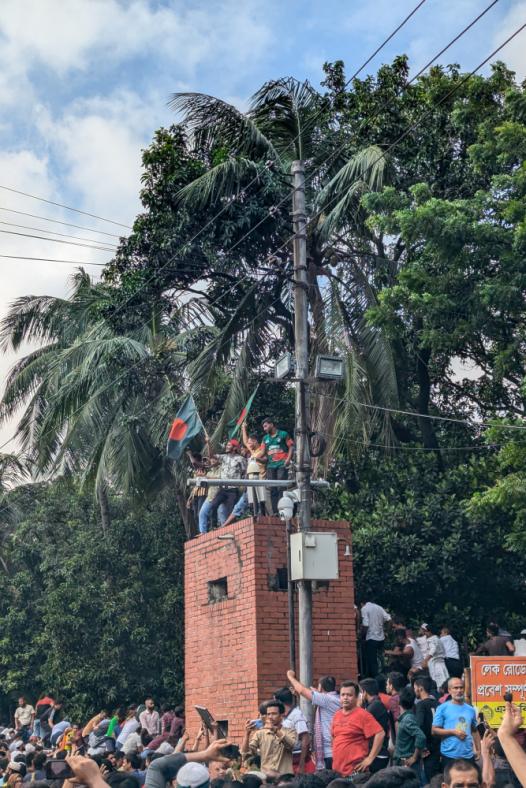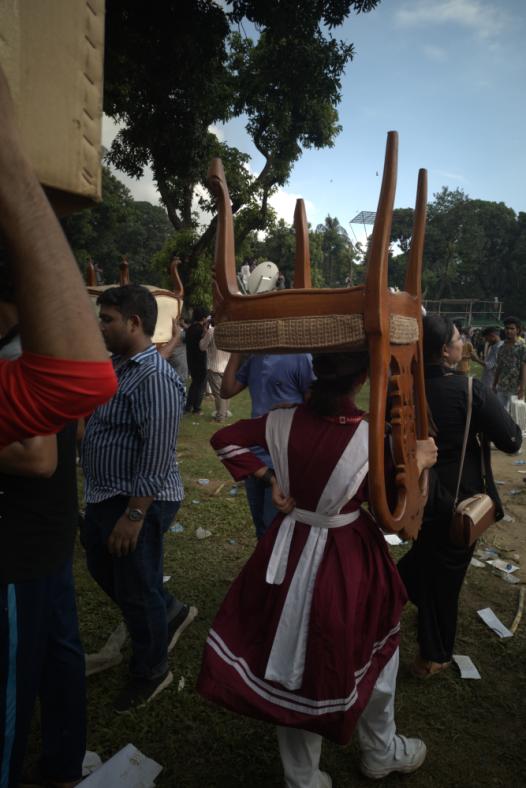On the morning of 5 August, there was still fear in the air.
The day prior was the bloodiest day of the protests. On 5 August, internet coverage was spotty in the morning, raising fears of a recurrence of the complete blackout that had plunged the country into digital darkness for more than a week in late July.
Everyone had an idea of what was happening, but details were scarce, leaving only the darkest questions in mind.
How many people had been slain on the orders of 'public servants' in the past 24 hours? How many more would lose their lives today? Was the army really going to take up arms to stop students and the general populace from voicing their displeasure? Which of our friends or family would we never interact with again?
Among all these, however, one question kept bubbling to the surface: Are we going to let this policy of wanton violence stop us?
The call for the long march had been heard by all, but when we awoke on August 5, there was little indication of whether those plans had been shelved or whether those making the charge were already being brutalised.
The army chief urged everyone to stay at home, hinting that an announcement was on the cards. Still, with trepidation in their hearts and little patience to hear yet another statement from a prime minister who had become more deluded and melodramatic by the day, the masses stepped out.
On the streets, unlikely allies united against one entity: the authoritarian. It did not take long until the realisation that something monumental would happen began to dawn.
It started off as a stream, with dozens marching alongside us from Lalmatia to Dhanmondi 27. By the time you turned the corner onto Mirpur Road, the path that led to Gono Bhaban, the prime minister's residence, the wave of people had become no less than a tsunami.
The premier had invited the people to her home the day prior. It was an invitation the masses were in no mood to decline.

However, midway into the march, something unexpected happened. Unbeknownst to most of those on the streets, the army chief had belatedly made his announcement.
Suddenly, men and women began to run, shout, and cheer.
The moment the details of his announcement became clear occurred when a man in his 50s, wrapped in the most beautiful hues of red and green, provided the rallying call: "Palaise re palaise, Sheikh Hasina palaise."
In those next moments, it seemed almost everyone in the crowd had a phone to their ear, attempting to unravel whether this was indeed what had happened.
Not even a few minutes later, courage gave way to celebration. The chant the man had cried out echoed through the wave.
Sheikh Hasina had indeed left the country, ushered away in a military aircraft without being given a chance to bid farewell.
Within an hour, pictures began to circulate of students traipsing around Gono Bhaban, drinking the tea meant for the prime minister and eating her food.
These simple acts took on a greater meaning, spurring the crowd to move faster. People were not just drinking or eating, they were taking back what had been bought with money looted from them for over a decade.
By the time most people arrived near Gono Bhaban, celebrations were in full swing. Young people rested atop police boxes and perched on corner walls, waving the Bangladesh flag. There was little space to move.

However, if you got there early enough, every few minutes you would have seen someone passing through the gate, closed moments later, carrying a memento they had gathered from the Gono Bhaban. One man was carrying a chair, another a stool.
Although theft in name, this act transcended that notion. What they were doing was more akin to reclamation. After all, what did the lady who proudly showed off a box of empty tissues emblazoned with the words "Gono Bhaban" stand to gain financially?
How much does a chair or a stool sell for? How many meals would the two ducks that a man snagged from the prime minister's pond provide for his family, let alone the people he was inviting to a celebratory feast?
For the overwhelming majority of people who took something, they did not do so for the monetary value of the items; they did it to assure themselves that they had their power back.
Inside the lair of an autocrat
While celebrations erupted all around, people were attempting to scale the walls of Gono Bhaban from all sides. Many succeeded.
As it soon dawned, getting inside was the easy part.
The way out – a big, iron gate – had been locked. The line for the exit stretched from the vast open spaces to within the borders of the prime minister's residence itself. Those in that line were carrying anything and everything that they could get their hands on.
Most of it was harmless: a stove, a broom, rugs. Standing out even among this wild and unprecedented scene was the figure of a young girl, dressed in her school uniform, carrying a chair above her head as she waited in line. She had earned this.

But something more sinister was also brewing. Groups of men were carrying air conditioners, lawnmowers, computers, and large pieces of furniture. Then there were the paintings, undoubtedly among the more expensive items.
A man held under his arm a behemoth of a painting, depicting the great Royal Bengal Tiger. Another held a faded painting of the countryside. In the trash, there lay another iconic painting, butchered by an unappreciative mind.

At this point, one would have thought they had seen the seedy underbelly of this operation. It was clear that many of these people, especially the ones with pillowcases full of plunder, perhaps had a profit motive.
But things only got worse upon approaching the residence of the PM herself.
Outside, cheers and laughter dominated the landscape.
One step inside, and all one could hear was the crashing of glass, the bludgeoning thumps of walls being torn down. For some reason, perhaps broken plumbing, the floor was submerged in about half-an-inch of water and caked with glass.
The sound was terrifying, the source even more so. Everything near the entrance was being disassembled. Air conditioners were being beaten out of the walls with imprecision. The walls were being shattered with makeshift weapons while whole doors were chopped apart.
Again, some of it was clearly driven by the will to make a buck. But the faces of a few others made it clear that their actions, to them, were a visceral dismantling of an autocrat's bloody legacy.
Other unwanted elements also existed. At least four fires were started during the author's foray into the compound. Encouragingly, these arsonists faced immediate reprimands from those around, and the fires were quickly put out.
Yet, unbridled rage was not the defining feature of the day. In a sea of complex emotions, those of liberation, relief, unity and happiness shone much brighter.
In the downstairs sitting area, things were calmer. Some students had claimed a sofa set, not allowing anyone to steal it away. Instead, they sat there, melancholic about their friends who had been injured and at the same time revelling in the glory that they felt.
A group of 20-somethings, if that, sat around the halls of the autocrat and smoked cigarettes, defiant of every inch of power that had once dared to try and subdue them.
There were many kindred spirits outside.
Pictures of Hasina and her family, framed throughout the residence, were now scattered across the gardens. When people took notice of those pictures, they did not bother to pick them up or even take them as mementos. Instead, they were used as floor mats, with each passerby slowing their pace or adjusting their gait to ensure their feet would graze the fallen face.
A few people who had entered the compound did not even claim anything; nor did they bother to wander inside the residence. Exhaustion from the emotional roller coaster had finally caught up to them. Once they realised the dictator was truly gone, they simply lay down.
In the shade of the mango and jackfruit trees, inches from frenzied revelry, these people were sleeping peacefully, perhaps for the first time in weeks.

When it finally came time to leave, panic was the only recourse. All the ways out were blocked and people were packed together like sardines as they attempted to get in line to leave.
At one point, shouts from the outside warned people to move away from the walls. They would soon have a way out, but it was being created by a makeshift battering ram. Many did not heed the initial warnings, but when the thumping began and the walls began to shake, people ran for cover.
By some miracle, a stampede was narrowly avoided.
As the light of day began to fade, the door had still not opened. Many simply went out the way they had come in, up and over. Others waited till the big doors finally swung open.
This, of course, did little to help. The air still hummed with the electricity of a people unshackled.
Hundreds more were waiting at the gates to get in.
This led to a short but pitched pushing contest before cooler heads prevailed. Students, those perched atop the walls, began bellowing out orders and admonishment. The people inside would have a dedicated lane to exit, if only for a while.
And so, the long march ended – not with a manifesto or a coronation, but with ordinary men and women carrying pieces of a broken palace back to their homes. The fires had been doused, the walls bore the scars of their reclamation, and the faces of the fallen regime lay trampled in the dirt. A chair, a stool, a duck: these were not spoils of war, but fragments of a stolen dignity, now reclaimed.
A quiet question also lingered: What now?
The dictator was gone, but her shadow stretched long over a nation that had yet to reckon with the machinery of oppression she left behind.
The road ahead was uncertain, littered with the debris of the old world.
But for now, in the echoes of festivity, there was victory.
It was not the kind of orderly triumph that is found in story books, but the messy, visceral kind – the kind that begins with whispers of fear and ends with a nation that refuses to be afraid anymore.



Comments